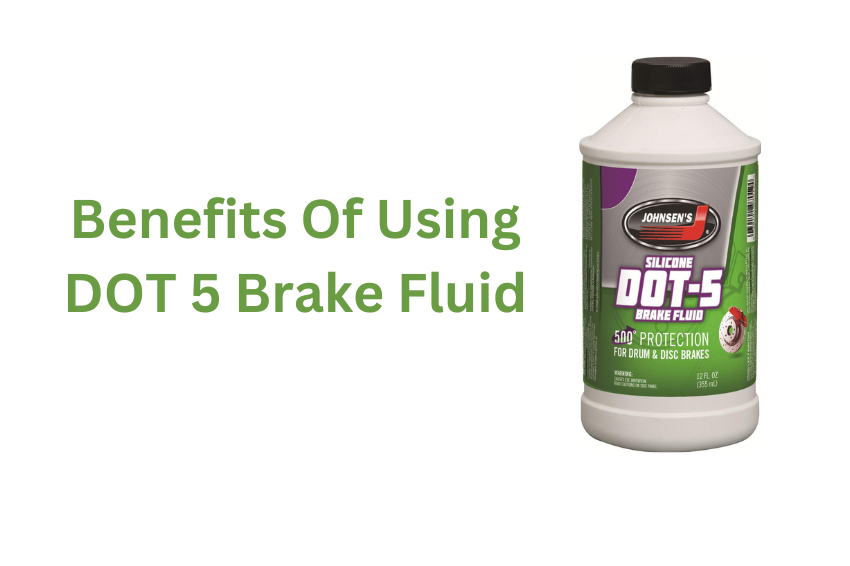Are you considering upgrading your brake fluid?
DOT 5 is a popular choice for its many benefits.
However, In this guide, you’ll learn about the advantages of DOT 5 and help you decide if it’s the right choice for your vehicle.
Key Takeaway
- DOT 5 Offers exceptional Heat Resistance
- DOT 5 is Non-Hydroscopic
- DOT 5 May Not Be Compatible with All Vehicles
- DOT 5 Can Be More Expensive
What Are The Advantages Of DOT 5 Brake Fluid?
Here are some of the key benefits of using DOT 5 brake fluid:
Exceptional Heat Resistance
One of the most significant advantages of DOT 5 is its exceptional heat resistance.
This is important for performance vehicles, heavy-duty applications, and situations where you need to brake hard repeatedly.
When DOT 5 gets hot, it doesn’t boil as easily as DOT 3 or DOT 4.
This means your brakes are less likely to fade, providing reliable stopping power even in extreme conditions.
Non-Hydroscopic Properties
Unlike DOT 3 and DOT 4, DOT 5 is non-hydroscopic.
It doesn’t absorb moisture from the air.
Moisture can reduce the boiling point of brake fluid, making it more likely to vaporize and cause brake fade.
With DOT 5, you can enjoy consistent braking performance over a longer period without needing frequent fluid changes.
Longer Lifespan
Because DOT 5 doesn’t absorb moisture, it can last much longer than DOT 3 or DOT 4.
This can lead to reduced maintenance costs and fewer brake fluid flushes.
Improved Brake Feel
Some drivers report a better brake feel when using DOT 5 brake fluid, which is because DOT 5 can provide a more consistent and responsive braking experience.
Is DOT 5 Brake Fluid Safer Than DOT 3 Or DOT 4?
DOT 5 brake fluid is often considered safer than DOT 3 or DOT 4 due to a few key factors.
Here are some key differences:
Boiling Point
One of the most important aspects of brake fluid safety is its boiling point.
When brake fluid boils, it can create air pockets in your brake lines, reducing braking power.
DOT 5 has a higher boiling point than (500 F dry/356 F wet) DOT 3 or DOT 4, especially when dry.
Moisture Absorption
Moisture can lower the boiling point of brake fluid, making it more likely to vaporize and cause brake fade.
DOT 5 is non-hydroscopic, meaning it doesn’t absorb moisture from the air.
This helps it maintain its high boiling point over time to ensure consistent braking performance.
How Does DOT 5 Brake Fluid Handle High Temperatures?
DOT 5 brake fluid is specifically designed to handle high-temperature conditions.
This is due to its exceptionally high boiling point.
Unlike DOT 3 and DOT 4, which can boil and vaporize under extreme heat, DOT 5 remains in a liquid state.
The boiling point of DOT 5 can vary slightly depending on the specific brand, but it generally ranges from around 500°F (260°C) to 600°F (315°C) when dry.
This is significantly higher than the boiling points of DOT 3 and DOT 4, which typically range from 360°F (182°C) to 400°F (204°C) when dry.
Why is boiling point so important? When brake fluid boils, it creates air pockets in your brake lines.
These air pockets can make your brakes feel spongy and reduce their stopping power, which is known as brake fade.
Brake fade can be extremely dangerous, especially during emergency stops.
DOT 5’s high boiling point means it’s much less likely to vaporize, even during intense braking or in hot weather.
This makes it ideal for performance vehicles, such as sports cars and race cars, which often experience extreme temperatures and demanding braking conditions.
In addition to performance vehicles, DOT 5 is also a great choice for off-roading.
Off-road trails can be rough and challenging, and your brakes may be subjected to a lot of heat and stress.
DOT 5 can help you maintain control and avoid brake fade, even in the most demanding conditions.
Is DOT 5 Brake Fluid Compatible With All Vehicles?
DOT 5 brake fluid is not compatible with all vehicles.
While it offers lots of advantages, including excellent heat resistance and non-hydroscopic properties, it’s essential to check your vehicle’s owner’s manual for specific recommendations.
Many modern vehicles with ABS systems are designed to work with DOT 3 or DOT 4 brake fluids.
Using DOT 5 in an ABS can lead to compatibility issues and potential brake failures.
Some older vehicles may also have brake systems that are not compatible with DOT 5.
This is especially true for vehicles manufactured before the 1990s.
Never mix DOT 5 with DOT 3 or DOT 4.
Doing so can cause serious damage to your brake system.
However, the best way to determine if DOT 5 is compatible with your vehicle is to consult your owner’s manual.
It will provide specific recommendations for the type of brake fluid to use.
If you’re unsure about the compatibility of DOT 5 with your vehicle, it’s always best to consult with a qualified mechanic.
